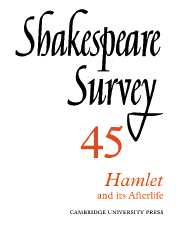Book contents
- Frontmatter
- The Reception of Hamlet
- ‘Hamlet, Revenge!’: The Uses and Abuses of Historical Criticism
- Revision by Excision: Rewriting Gertrude
- Gazing at Hamlet, or the Danish Cabaret
- ‘He’s Going to his Mother’s Closet’: Hamlet and Gertrude on Screen
- Shakespeare Rewound
- Freud’s Hamlet
- ‘Pray you, undo this button’: Implications of ‘Un-’ in King Lear
- Marx and Shakespeare
- Peter Street, 1553–1609: Builder of Playhouses
- Shakespeare Performances in England 1990–1
- Professional Shakespeare Productions in the British Isles, January–December 1990
- 1 Critical Studies
- 2 Shakespeare’s Life, Times, and Stage
- 3 Editions and Textual Studies
- Books Received
- Index
‘He’s Going to his Mother’s Closet’: Hamlet and Gertrude on Screen
Published online by Cambridge University Press: 28 March 2007
- Frontmatter
- The Reception of Hamlet
- ‘Hamlet, Revenge!’: The Uses and Abuses of Historical Criticism
- Revision by Excision: Rewriting Gertrude
- Gazing at Hamlet, or the Danish Cabaret
- ‘He’s Going to his Mother’s Closet’: Hamlet and Gertrude on Screen
- Shakespeare Rewound
- Freud’s Hamlet
- ‘Pray you, undo this button’: Implications of ‘Un-’ in King Lear
- Marx and Shakespeare
- Peter Street, 1553–1609: Builder of Playhouses
- Shakespeare Performances in England 1990–1
- Professional Shakespeare Productions in the British Isles, January–December 1990
- 1 Critical Studies
- 2 Shakespeare’s Life, Times, and Stage
- 3 Editions and Textual Studies
- Books Received
- Index
Summary
It is now almost a truism that the universality of videotape has made Shakespeare accessible as never before; or more to the point, has made certain productions of Shakespeare endlessly repeatable at the flick of an armchair switch. The availability of this or that acted version of a Shakespeare play is thus for the first time simply a technological achievement. There is no use lamenting this fact, even if we wish to; wiser rather to assess its likely influence, for better or worse, on Shakespeare criticism and appreciation, both learned and popular: a larger issue than can be attempted here.
This essay considers those four modern productions of Hamlet that are easily the most visible, because the most easily viewable. They are, first, the black-and-white film made in 1947, which Laurence Olivier produced, directed, adapted, and starred in; second, the colour film of 1969, with Nicol Williamson, directed by Tony Richardson; third, the BBC television version of 1980, with Derek Jacobi, directed by Rodney Bennett; and, as a brief coda, the most obviously 'popular' of the four, Franco Zeffirelli's 135-minute colour film of 1990, which is set fair to guide young viewers of the play in particular as the same filmmaker's Romeo and Juliet (1967-8) did their parents. This Hamlet, more than any other on stage or screen, is likely to define and even precede their understanding of Shakespeare's text. The New York Times proclaimed it 'a drama that speaks easily and directly to our own age . . . Mel Gibson may not be a Hamlet for the ages, but he is a serious and compelling Hamlet for today'.
- Type
- Chapter
- Information
- Shakespeare Survey , pp. 53 - 62Publisher: Cambridge University PressPrint publication year: 1992
- 1
- Cited by



